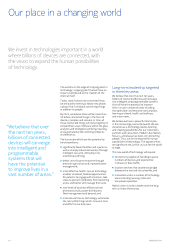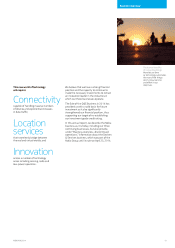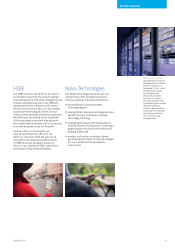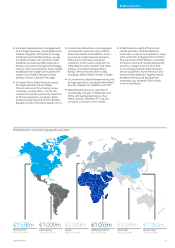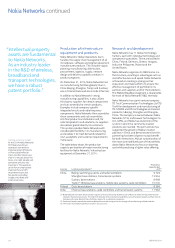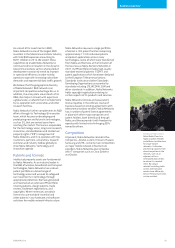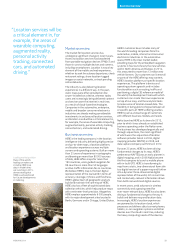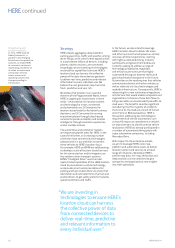Nokia 2014 Annual Report Download - page 22
Download and view the complete annual report
Please find page 22 of the 2014 Nokia annual report below. You can navigate through the pages in the report by either clicking on the pages listed below, or by using the keyword search tool below to find specific information within the annual report.
20 NOKIA IN 2014
Nokia Networks continued
Strategy
Nokia Networks’ industry is characterized
by rapid technological development, and we
see the following as the key trends within
the industry.
■ The number of connected devices is likely
to increase significantly by 2025. We
forecast that there will be over seven billion
connected people and more importantly
over 50 billion connected things in the
world by 2025. We expect analytics to play
apivotal role in bringing meaning and value
to this programmable world.
■ We expect the exponential growth in mobile
data traffic tocontinue. We forecast that
global mobile data traffic will grow by
40%annually through 2025. Each mobile
broadband user will use multiple gigabytes
of data daily. Carrier aggregation technology
will be key in enabling the massive traffic
inultra-dense LTE networks.
■ High performance, quality and reliability
in networks are likely to become even
more important. As networks carry ever
more data traffic, their high performance
will be critical, in addition to their quality
and reliability.
■ The transition of network functionalities
to the cloud is likely to enable faster
deployment of networks and reduction
of costs, and help Nokia Networks’
customers provide a better experience
to their own customers.
■ Automation of services is likely to increase
across every stage of network lifecycle for
high service quality and efficiency.
■ Partnering in the complex ecosystem is
likely to become increasingly important.
With the complexity of networks increasing,
partnering and cooperation between
vendors will be required in the merging
telecommunications and IT industries.
Nokia Networks, to respond to these trends
and capitalize on its strengths, has four focus
areas in its strategy:
1. Accelerating leadership in radio
Nokia Networks will remain focused on the
radio business, aiming to grow its market
share further in LTE and LTE-Advanced and
to gain leadership in 5G, small cells and radio
cloud, while maintaining its overall market
position. Nokia Networks is constantly
developing its portfolio to oer all the
technology elements in a base station site,
whether through its own products or
partnering, including items such as antennas,
backhaul and fronthaul. Nokia Networks will
also oer integrated small cells and Wi-Fi
technologies to handle the large proportion
of mobile data trac that is generated by
users indoors. Another example of how
Nokia Networks is developing its portfolio is
the use of its LTE capabilities to target new
market areas, such as LTE-based public
safety solutions.
2. Growing professional services
Nokia Networks aims to grow its services
business overall to become the leading
network implementation vendor with the
highest quality and to become the best in
the care business. Nokia Networks is also
taking steps to increase its proportion of
professional services revenue: by growing
areas such as network planning and
optimization for heterogeneous networks;
leveraging its 3D geo-location capabilities;
and growing its systems integration business
with carrier-grade services to enable Telco
Cloud, Internet of Things, analytics and
security. Additionally, Nokia Networks aims
to grow its managed services business
through a portfolio in predictive operations,
smart learning and software as a service.
Automation and remote delivery will continue
to be emphasized as part of an ecient
service delivery model.
3. Winning in technology transition
to the Telco Cloud
The third focus area of Nokia Networks’
strategy is based on opportunities arising
from the technology transition to Telco Cloud.
Nokia Networks is in a good position to benet
from its strength in Network Functions
Virtualization (“NFV”), but its ambitions
are also to become a domain aggregator in
Telco Cloud and expand its business through
Software Dened Networking. Nokia Networks
also plans to expand into network and service
orchestration and management, which will
extend its capabilities to allow for automated
arrangement, coordination and management
of all network elements. To round out its
end-to-end Telco Cloud oering, Nokia
Networks has started to build a strong
security portfolio. We believe that the
transition to the cloud will give rise to
next-generation security threats and new
regulation, and we want to ensure a secure
transformation for our customers.
Creating a network
for the future
The Telco Cloud proof
of concept with Nokia
Networks is a signicant
step forward in Orange’s
strategy to leverage the
power of Telco Cloud
and NFV, targeting a more
agile service launch as well
as self-healing networks
and automated operations
for networks.


